G
Guest
Guest
Review: Old vs New Kingsford® Charcoal
Let me start by saying that this is probably the longest, most picturesque,
most in-depth, and most scientific post that I've written to date.
Kingsford® has changed their "blue bag" formulation yet again, and I think
it deserves a fair investigation.
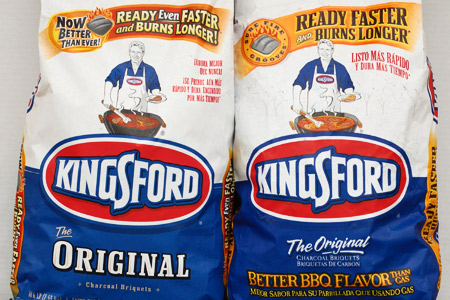
As you can see by the claim on the bag in the image above (left bag), the
new formulation is "ready even faster and burns longer". This is clearly
good news, if it holds true.
Just for background, the new Kingsford® comes from an apparent "green"
initiative by the company. In short, they sought to produce a product that
yields the same amount of heat, but in a smaller package. The bag is
lighter, which means more bags in a truck, which translates to less trucking
miles, and therefore less emissions.
As I mentioned, this is all well and good, so long as I get the same or more
bang for the bag. Let's dive in and see how this new stuff stacks up.
I wanted this review to be as fair and impartial as I could make it at home.
I don't have a laboratory, but I am an engineer, so I did the best that I
could. I ran side-by-side tests of two brand new off-the-shelf bags of the
old and the new. As you will see, I've weighed and photographed each
product so that you can see exactly what I saw.
Here goes...
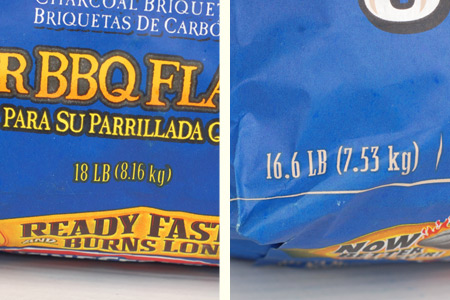
As you can see, the new bag is 1.4 pounds lighter than the previous
formulation.
Note: From here on the old briquettes are pictured on the left, and the
new are on the right.
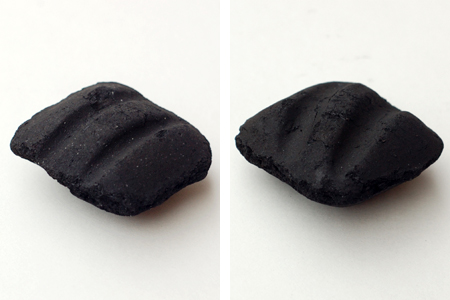
The new briquettes are about the same size, but they appear to be more
tightly compressed and feature larger and deeper grooves. As you can see,
the new grooves are diagonal.
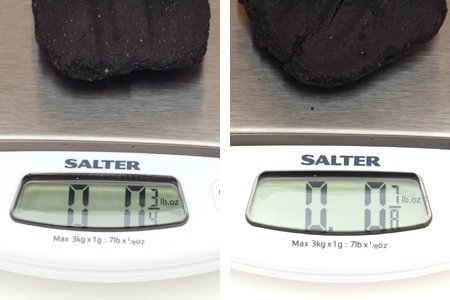
I weighed various quantities of the old and the new briquettes and here is
how they compared:
Quantity | Old Weight | New Weight
1 briquette | 3/4 oz | 7/8 oz
5 briquettes | 4 1/4 oz | 4 3/8 oz
10 briquettes | 8 3/8 oz | 8 5/8 oz
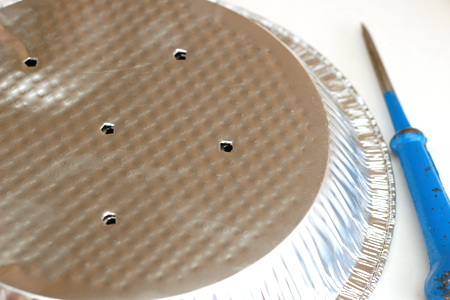
For the burn test, I punched two aluminum pie pans with an identical
pattern of six holes. I wanted to use a method that would contain the ash
for a final weight, as you will see later.
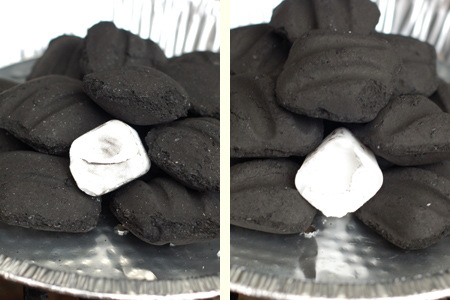
I arranged the old and new briquettes in each pan as similarly as I could. I
used 12 briquettes in each, in layers of six, four, and two (all with the
grooves facing upward). I put a single Weber wax starter cube in each pile.
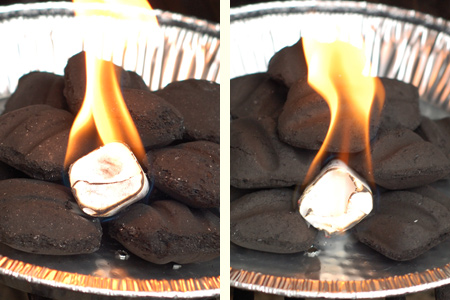
I lit each cube and took pictures at five-minute intervals. For those
interested, the temperature was 48º and the humidity was 52%.
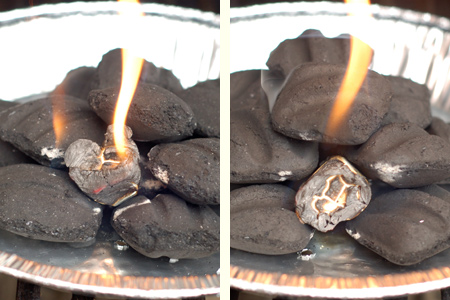
At five minutes.

At 10 minutes.
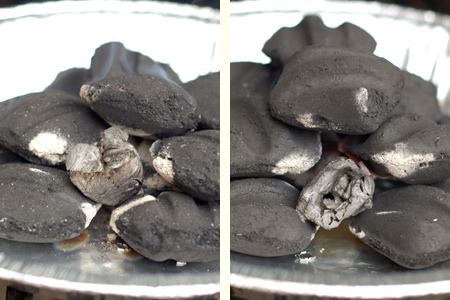
At 15 minutes.
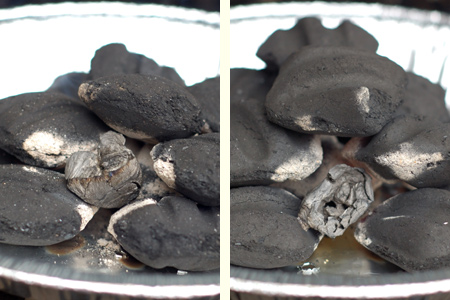
At 20 minutes.
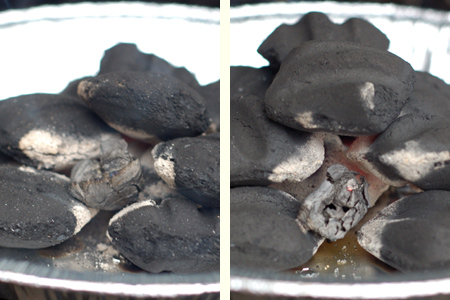
At 25 minutes. I started taking temperature measurements at this point. I
used an infrared thermometer on the bottom of each pan at the 9 o'clock
position.
Old: 459º
New: 334º
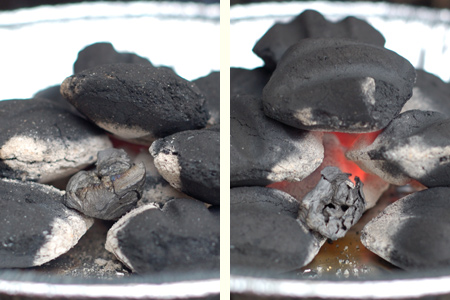
At 30 minutes.
Old: 478º
New: 313º
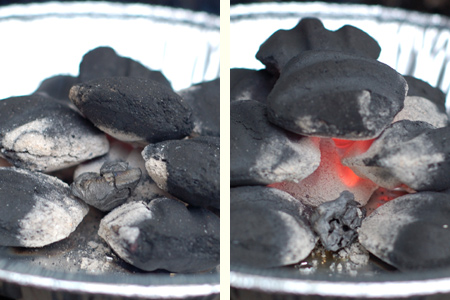
At 35 minutes.
Old: 426º
New: 389º
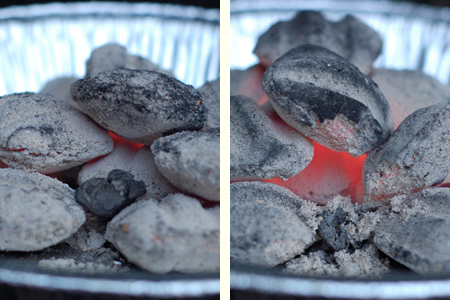
At 60 minutes.
Old: 431º
New: 557º
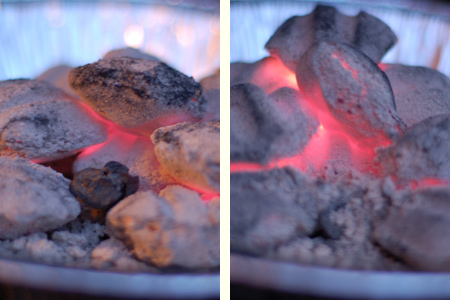
At 90 minutes.
Old: 244º
New: 325º
I stopped taking pictures at 90 minutes, but I continued reading the
temperatures out to 180 minutes.
Here is a chart that shows the old and new temperatures over time. The
horizontal axis is time and the vertical shows the temperatures.
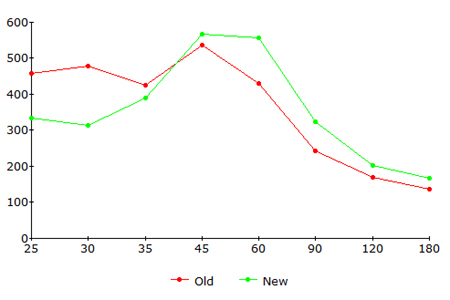
What about ash? Well, as you can see below, they are very close, but the
new stuff produces slightly less by weight (3 oz vs. 2 1/2 oz).
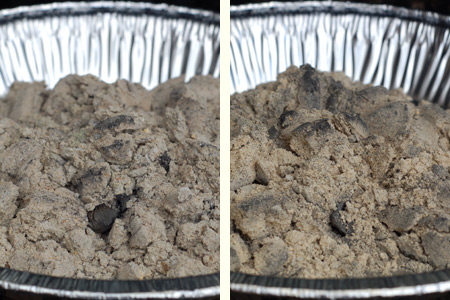
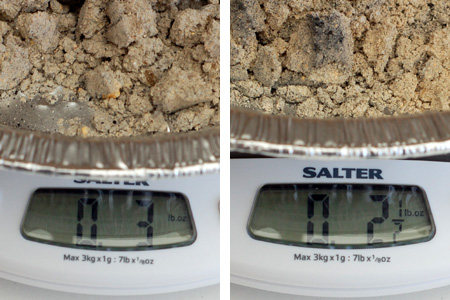
OK, so what does all of this really mean? The bottom line for me is that,
based on my testing, the new product lives up to its claims. In fact, I think
it's better than they claim.
While you could argue that it starts slower, I think the crossover
temperature at roughly 500º is a good indication that they really are
comparable out of the gate.
As the chart above shows, it does indeed burn longer (and even hotter)
over the long haul. Combine that with less ash weight, and I think it's an
all-around better product.
Note: The new formula is far less smokey starting up than the old
formula. I'd estimate that the old stuff smokes four to five times as
much.
-----
John
Let me start by saying that this is probably the longest, most picturesque,
most in-depth, and most scientific post that I've written to date.
Kingsford® has changed their "blue bag" formulation yet again, and I think
it deserves a fair investigation.

As you can see by the claim on the bag in the image above (left bag), the
new formulation is "ready even faster and burns longer". This is clearly
good news, if it holds true.
Just for background, the new Kingsford® comes from an apparent "green"
initiative by the company. In short, they sought to produce a product that
yields the same amount of heat, but in a smaller package. The bag is
lighter, which means more bags in a truck, which translates to less trucking
miles, and therefore less emissions.
As I mentioned, this is all well and good, so long as I get the same or more
bang for the bag. Let's dive in and see how this new stuff stacks up.
I wanted this review to be as fair and impartial as I could make it at home.
I don't have a laboratory, but I am an engineer, so I did the best that I
could. I ran side-by-side tests of two brand new off-the-shelf bags of the
old and the new. As you will see, I've weighed and photographed each
product so that you can see exactly what I saw.
Here goes...

As you can see, the new bag is 1.4 pounds lighter than the previous
formulation.
Note: From here on the old briquettes are pictured on the left, and the
new are on the right.

The new briquettes are about the same size, but they appear to be more
tightly compressed and feature larger and deeper grooves. As you can see,
the new grooves are diagonal.

I weighed various quantities of the old and the new briquettes and here is
how they compared:
Quantity | Old Weight | New Weight
1 briquette | 3/4 oz | 7/8 oz
5 briquettes | 4 1/4 oz | 4 3/8 oz
10 briquettes | 8 3/8 oz | 8 5/8 oz

For the burn test, I punched two aluminum pie pans with an identical
pattern of six holes. I wanted to use a method that would contain the ash
for a final weight, as you will see later.

I arranged the old and new briquettes in each pan as similarly as I could. I
used 12 briquettes in each, in layers of six, four, and two (all with the
grooves facing upward). I put a single Weber wax starter cube in each pile.

I lit each cube and took pictures at five-minute intervals. For those
interested, the temperature was 48º and the humidity was 52%.

At five minutes.

At 10 minutes.

At 15 minutes.

At 20 minutes.

At 25 minutes. I started taking temperature measurements at this point. I
used an infrared thermometer on the bottom of each pan at the 9 o'clock
position.
Old: 459º
New: 334º

At 30 minutes.
Old: 478º
New: 313º

At 35 minutes.
Old: 426º
New: 389º

At 60 minutes.
Old: 431º
New: 557º

At 90 minutes.
Old: 244º
New: 325º
I stopped taking pictures at 90 minutes, but I continued reading the
temperatures out to 180 minutes.
Here is a chart that shows the old and new temperatures over time. The
horizontal axis is time and the vertical shows the temperatures.

What about ash? Well, as you can see below, they are very close, but the
new stuff produces slightly less by weight (3 oz vs. 2 1/2 oz).


OK, so what does all of this really mean? The bottom line for me is that,
based on my testing, the new product lives up to its claims. In fact, I think
it's better than they claim.
While you could argue that it starts slower, I think the crossover
temperature at roughly 500º is a good indication that they really are
comparable out of the gate.
As the chart above shows, it does indeed burn longer (and even hotter)
over the long haul. Combine that with less ash weight, and I think it's an
all-around better product.
Note: The new formula is far less smokey starting up than the old
formula. I'd estimate that the old stuff smokes four to five times as
much.
-----
John
